The property market is booming and online ads are one of the main reasons why!
There’s no doubt about it—online ads have had a huge impact on the way we buy and sell a property. They’ve leveled the playing field, making it possible for small businesses to compete with big brands. And they’ve given buyers and sellers a much wider choice of properties to choose from.
But that’s not all. Online ads have also made the process of buying or selling property much faster and easier.
In fact, you can now close a deal in just a few days using nothing but online ads (no print ads and local commercials needed). If you're a real estate agent or property provider and you've never had success in any of your online real estate ads, then this guide is for you!

Table of Contents
Online Marketing Techniques for Real Estate Ads
Real Estate Ads on Meta (Facebook and Instagram)
Promoting Real Estate Property using Native Advertising
It's no secret that online advertising has taken over the world. We are constantly bombarded with ads on social media, websites, and even in our email inboxes.
So how can you make your real estate advertising stand out from the rest?
With so many rivals, it can be hard to get your real estate ad seen, let alone clicked on. In order to snag a piece of the pie, you need to be aggressive and stand out from the competition.
The answer is simple: be creative! With a little outside-the-box thinking, you can create real estate advertising that will grab attention and help you close fast.
To boost foot traffic on listings you want to sell, improve your real estate business' brand, and enhance lead generation, there are several things you can do.
However, we highly recommend using Meta Ads (Facebook and Instagram) or native advertising, or a combination of both. Keep reading to see how you can craft creative real estate ads that let you close fast!
Online Marketing Techniques for Real Estate Ads
Before you start making advertisements, you must first analyze the marketing principles behind high-performing real estate ads. Only then can you create ads that will actually work.
Anyone who has ever looked for a new home knows that there are endless real estate ads to sort through. To stand out from the crowd, it is important to create ads that are both eye-catching and informative.
Here are a few marketing techniques to keep in mind when creating real estate advertising campaigns.
Tell a Story
When creating your real estate ad, it is important to tell a story that will resonate with your audience.
The story should be relatable, emotional, and make use of powerful words. It should also be relevant to the property you are trying to sell.
Storytelling is one of the most useful marketing techniques that realtors often overlook. A good story will make your ad stand out and will be more likely to stay in the viewer’s mind.
For example, if you are selling a family home, you could tell the story of a young couple who just had their first child and are looking for more space.
Or if you are selling a retirement home, you could tell the story of an elderly couple who downsized and are now looking for a simpler life.
The key is to find a story that potential buyers can relate to and that will make them want to learn more about the property.
You may think that you'll only be using a story for one listing, but that's not true. In reality, you can simply tweak the story to match other listings. Or you can create half a dozen story templates and utilize them when appropriate for the property.
You can have the following templates (this is just a sample list, but you can expand even further):
-
For a young couple still enjoying the early stages of marriage
-
For an old couple wanting to have peace and quiet
-
For a single male who is looking to entertain or have friends over
-
For a confident and independent female looking for a chic and comfortable place
-
For new owners with pets
-
For business-minded individuals looking for investment options
-
For a growing family seeking private spaces for every member of the family.
When creating a narrative, make sure you keep your target market in mind. No matter how great your story is, if it misses the mark, then it will all be a waste. Here's an article on target marketing to help you with this aspect.

Now here's an example of a story of how you can attract a young couple still enjoying the early stages of marriage to buy this home:
You've just started your life together. You're in love and nothing can bring you down. You're finally ready to start your own family and buy a home of your own. But where do you start? How do you find the perfect home that will suit your needs?
If you're looking for a family home, this is the perfect property for you. It has everything you need: plenty of space, a backyard, and a great location. Plus, it's close to good schools and parks.
This home is the perfect place to start your life together. It has everything you need to raise a family. So what are you waiting for? Give us a call today and schedule a viewing. We know you'll fall in love with this home as much as we have.
Use Power Words
When creating your real estate advertising campaign, be sure to use powerful words that will resonate with your audience. The words you use should be emotive and make use of sensory language.
You want potential buyers to feel like they are already living in the home you are trying to sell.
For example, instead of saying “This three-bedroom home is perfect for a family,” you could expand it further by saying “This charming three-bedroom home is the perfect place to raise a family. It has plenty of space for your kids to run and play. Plus, the spacious backyard is perfect for summer BBQs.”
The second sentence is more effective because it uses words that evoke emotion and makes use of sensory language. The reader can imagine themselves in the home, and this will make them more likely to take action.
Some other power words you can use include:
-
Beautiful
-
Charming
-
Cozy
-
Elegant
-
Gorgeous
-
Inviting
-
Luxurious
-
Modern
-
peaceful
-
Private
-
Refined
-
Spacious
-
Stunning
Sprinkle them across your written or spoken creative and you're sure to land a hit.
Focus on the Benefits
Highlight any unique features that will appeal to your target market, then turn them into a benefit. For example, if you are selling a family home, you could mention the backyard, the nearby schools, or the kid-friendly neighborhood.
If you are selling a luxury home, you could highlight the gourmet kitchen, the wine cellar, or the home theatre which are great for entertaining a large number of guests.
Remember to focus on the benefits of these features. For example, don't just say that the home has a backyard. Instead, mention that the backyard is perfect for summer BBQs or that it's private and perfect for entertaining guests.
It's like incorporating these features into the story that you created (as discussed in the first point).
The more specific you can be, the better. The goal is to make potential buyers picture themselves living in your home and enjoying all that it has to offer.
Again, remember to highlight the benefits, and if you need to mention the features, how they can be beneficial to the client.
Promote Benefits Over Features—keep this in mind.
Use Strong Visuals
It's no secret that people are visual creatures. In fact, studies have shown that we process images 60,000 times faster than text. This is why it's so important to use strong visuals in your real estate ad.
Make sure to use high-quality images that are clear and well-lit. You want potential buyers to be able to see all the details of your home.

If you can, hire a professional photographer to take pictures of your property. If you can have the property staged, the better! It will be worth the investment, trust us.
In addition to photos, you could also use videos or even virtual tours. These days, there are many affordable options for creating videos and virtual tours. And like we said, the visuals should be appealing and of high quality.
Right now, videos are the most consumed content online. House tours can even be done virtually with these things!
Even better, video house tours reach more people and can even go viral. This is why video ads are a sure-hit for real estate property offers.
The bottom line is that you want to make sure your real estate advertising creative stands out from all the others. And one of the best ways to do that is with strong visuals.
Go Viral!
How do you ensure that you gain more interest in the property you are selling? By making your ad go viral!
There are many ways to make your ad go viral. But one of the most effective is by using social media. Platforms like Facebook and Instagram have billions of users, which means that your ad has the potential to reach a large audience.
When creating your real estate ad, be sure to use high-quality visuals (photos, videos, etc.) and include a strong call to action. You also want to make sure that your ad is relevant and timely.
For example, if you're selling a summer home, you could create an ad that features photos of people enjoying the pool or backyard.
Remember, you want potential buyers to see themselves in your home. And one of the best ways to do that is by showing them how it would look if they are currently occupying the home.
If your viral ad campaign for the real estate property becomes very popular, you will get offers left and right since people nowadays like to live in "popular" homes.
My home is the one featured in that viral video!

Learn How to Infect Your Audience with Viral Marketing to apply this technique to your real estate ad campaigns.
Include a Call to Action
Your ad should have a strong call to action that tells potential buyers what to do next. For example, you could say, "Call now for a free consultation," "Visit our website to learn more," or "Schedule a showing today."
But you can be more creative in this aspect.
Let's say for example you are using a video ad showing you or one of your agents showing the house around, towards the end of the video, you can make your video host invite the viewers to come and have a look at the open house themselves.
You'll even be treated to a refreshing drink!
Then provide the contact information or a link to a sign-up form. Make everything easy for the customer to move to the next stage of the marketing funnel.
The goal is to make it as effortless as possible for interested buyers to take action. Your CTA should be clear and easy to spot (or easy to hear). You don't want potential buyers to have to search for it.
And it should be relevant to the action you want them to take. If you can, include a clickable link in your ad so that people can be taken directly to your website or listing page.
A call to action is important because it helps conversion rates. In other words, it helps turn interested viewers into actual buyers. So, if you want to close fast, be sure to include a call to action in your real estate ad.
Use Native Advertising
Native advertising is a form of online advertising that blends in with the surrounding content. For example, if you're reading an article on a website, you might see an ad that looks like it's part of the article itself.
Native advertising is effective because it's less intrusive than other forms of online advertising, such as banner ads. And since it's less intrusive, people are more likely to pay attention to it.
When it comes to real estate advertising strategies, native advertising can be a great way to get your property in front of interested buyers. For example, you could create an ad that looks like an editorial article about what the reader needs to know before buying a home in a specific area.

Or, you could create an ad that looks like a blog post about the top 10 reasons to buy a home in your city.
The key is to make your ad look like it belongs on the website or platform where it's being published.
We'll show you some examples of effective real estate ads using the native format later.
Utilize Social Media
It's no secret that social media has taken over the world. Just about everyone has at least one social media account, and many people are active on multiple platforms.
This presents a unique opportunity for businesses to reach a large number of potential customers with their message.
For a real estate business, this means that utilizing social media for advertising is a smart move. With such a wide range of platforms to choose from, there are endless possibilities for being creative and capturing your audience's attention.
Social media is one of the most powerful tools in your real estate marketing arsenal. Platforms like Facebook and Instagram have billions of users, which means that your ad has the potential to reach a large audience.
However, simply posting a real estate ad is not enough to capture people's attention. To be truly successful, you need to be creative with your content.
For example, you could create a short video tour of a property or share before-and-after photos of a recent renovation. And don't forget to include a story to make the open house ad more interesting.
When creating your real estate ad, be sure to use high-quality visuals (photos, videos, etc.) and include a strong call to action. You also want to make sure that your ad is relevant and timely.
Keep in mind that different social media platforms have different strengths. For example, Facebook's biggest user demographic is Millenials, while Instagram is more visual and tends to be popular with younger users.
(Note: check our article on marketing to Millenials to learn more on how to advertise to this segment.)
When deciding which platform to use for your real estate ad, it's important to consider your audience and what type of content would be most effective on each platform.
Test Desktop and Mobile Ads Separately
With more and more people using mobile devices to access the internet, it's important to make sure that your real estate ad is optimized for mobile.

Mobile users have different needs and behaviors than desktop users. For example, they're more likely to be on the go and looking for quick information. They're also more likely to be using a smaller screen, so your ad should be designed with this in mind.
While these may sound like limitations, many real estate agents have sold properties through mobile-only audience targeting, so don't take it for granted!
To make sure that your real estate ad is effective on both desktop and mobile, it's important to test them separately (also known as split-testing). This way, you can see what works and what doesn't on each platform.
Real Estate Ads on Meta (Facebook and Instagram)
If you're not using Facebook and Instagram for your real estate business, you're missing out on a huge opportunity to reach potential clients.
These social media platforms offer unique targeting options that allow you to create an audience of people who have searched for similar listings.
If you're thinking about adding Facebook and Instagram ads to your real estate marketing mix, read on for more information about the benefits of using these platforms.
Benefits of Using Facebook and Instagram for Real Estate Ads
You've been hearing a lot about Facebook and Instagram ads, but you're not sure that they're right for your real estate business. Let us settle these misgivings right now.
Here's why Facebook and Instagram are great for real estate agents:
Targeting Options Unique to Real Estate Ads
When creating an advertisement on Meta for a piece of real estate, the information included will differ from that of a standard dynamic ad. It is more targeted and in tune with a realtor's needs!
This is because elements such as the property's exact location, how many bedrooms and bathrooms it house, the neighborhood, etc. all need to be taken into account in order to accurately represent the "product."
Take note that the catalog and Pixel requirements will be different than for a standard ad. However, Meta's ads take all of these factors into account, so you can create an accurate and effective ad that will help to sell the property.
As such, real estate advertisers may choose from a variety of targeting options that are tailored to their needs.
Capture the Attention of Those Already Interested
You can create a following of people who have previously looked for comparable properties.
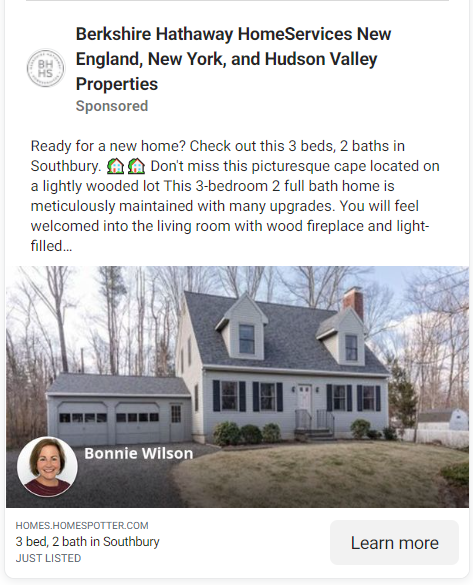
For example, someone who has previously viewed listings for 3-bedroom houses in a certain area is likely to be interested in a newly listed 3-bedroom house in that same area.
Facebook's Lookalike Audiences allow you to target ads to people who have similar characteristics to those in your existing customer base.
This type of targeting ensures that your ads are being shown to people who are already interested in what you're selling, which increases the likelihood of making a sale.
Generate High-Quality Leads
Another benefit of using Facebook and Instagram for real estate ads is that they allow you to generate leads.
When someone clicks on your ad, they are taken to a landing page where they can enter their contact information. This lets you collect leads and follow up with them at a later time.
The best part about using Facebook and Instagram for real estate ads is that they are extremely effective in generating leads that are of high quality. In fact, Facebook's lead ads have a 70% higher conversion rate than traditional landing pages.
Get Your Message in Front of More People
Organic reach on Facebook is declining, which means that your posts are being seen by fewer people. In order to get your message in front of more people, you need to use paid advertising.
Advertising on Facebook and Instagram allows you to reach a larger audience than you would through organic means. And because Facebook and Instagram ads are relatively affordable, they’re a great way to reach a large number of people without breaking the bank.
Catalog of Your Real Estate Properties for Sale
With Meta, you can upload an entire collection of homes and properties for sale so that you don't have to do it one by one. This is a unique feature that not all real estate marketing platforms have!
Plus, you can make use of Meta's powerful search engine to help people find the perfect property.
The listings on your website will be updated in real-time, so you don't have to worry about them being outdated. This is a huge time saver and ensures that your website is always up-to-date.
You can easily run dynamic real estate ads in any ad format you prefer. The best performing Instagram and Facebook ad formats for real estate include Carousel ads, Single Image Ads, and Video Ads.
Reach People at All Stages of the Home-Buying Process
With Facebook and Instagram ads, you can target people at all stages of the home-buying process.
For example, you can target people who are actively looking for a new home, as well as those who may not be actively looking but are still in the research phase.
You can also target people who have just purchased a home, as they may be interested in purchasing furniture, décor, or other items for their new home.
Examples of Real Estate Ads on Social Media
Now that we've gone over some of the benefits of using social media for real estate ads, let's have a look at these Facebook and Instagram ads to serve as inspiration for your next social media campaign.
1. ONE Sotheby's International Realty
This ad from ONE Sotheby's International Realty does a great job of showcasing one of their listings.
The ad features stunning photos combined with Power Words (we've discussed this above) such as "luxury", "breathtaking", and "one-of-a-kind". It's enough to convince any bachelor or bachelorette to grab the opportunity.

This next ad from the same agency focuses on family-oriented buyers, with keywords such as "charm", "prestigious", and "relaxing".
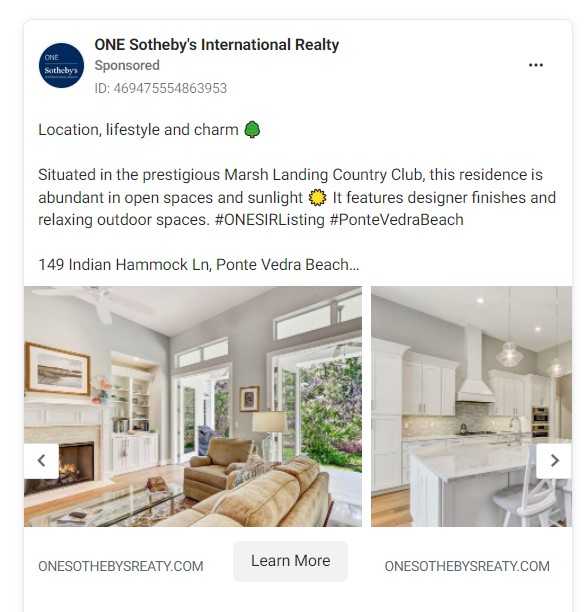
2. Better Homes and Gardens® Real Estate
This real estate business knows the value of real estate—even in ads! They utilized spacing within the text to highlight the message they want to convey.
For instance, the ad below starts with the line "Beautiful Home in Escondido!" which is easily noticeable.
While other advertisers would simply place the next part of the text, this real estate agency's advertiser knew that to make people immediately see what they want to say, adding a white space is a must.
Simply brilliant!
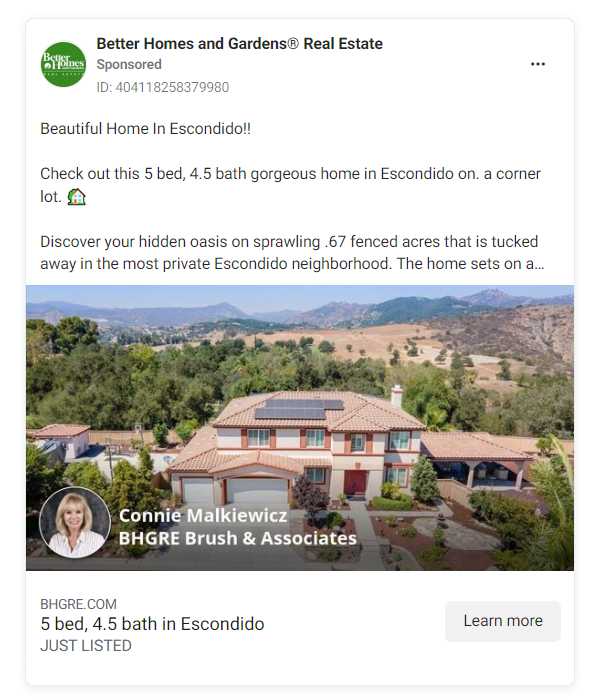
Another technique this agency utilized is telling a quick story that will make the readers imagine themselves living on the property.
"Soak up magnificent sunsets and views while dining outdoors or gather around the outdoor fire pit."
This definitely caught my imagination, what about yours?
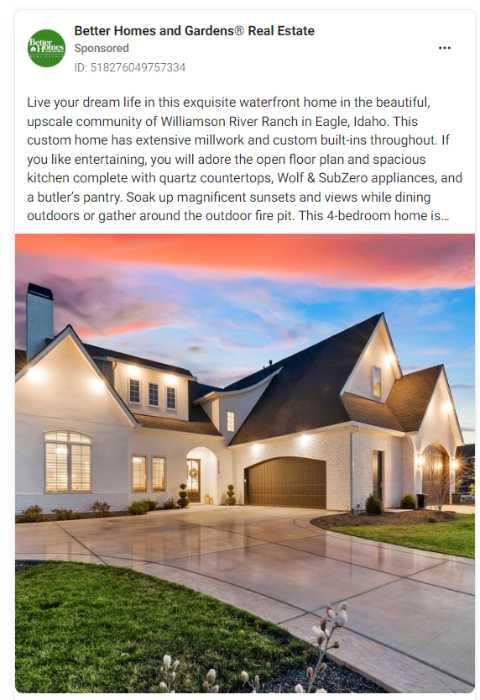
Remember that it's not always about selling—sometimes, it's also about building a brand and reputation.
If you want your clients to feel like you care about them, you can show them tips about home lifestyle and even maintenance. This gives the impression that you are not just out there to get a sale, which will convince your potential customers to trust your agency.

3. Anthem House
Anthem House is a new, luxury residential building in the heart of the Locust Point in Baltimore, Maryland. The building features spacious, modern apartments with incredible views of the city skyline.
To showcase the luxurious amenities and incredible views available at Anthem House, the marketing team created a video tour of one of the available units. The video tour gives potential residents a taste of what life would be like living in the building.
The video tour ad was created using Facebook and Instagram video ads, which allowed the team to target people who were interested in living in a luxury apartment in Baltimore. The video was also shot in a way that makes the viewer feel like they are right there in the apartment, experiencing all that Anthem House has to offer.
***
Facebook and Instagram ads are a great way to market your real estate business. The targeting options and ad templates available make it easy to create an effective ad that will reach a large number of people.
And because Facebook and Instagram ads are relatively affordable, they’re a great way to reach a large number of people without breaking the bank.
Promoting Real Estate Property using Native Advertising
As a real estate agent, you are always looking for new and innovative ways to market your listings. With the rise of native advertising, you now have a powerful tool at your disposal.
Native advertising is a type of online advertising that blends in with the surrounding content.
For example, if you are reading an article about home buyers in your area, you might see an ad for a local real estate agent next to the article. Because native ads are less intrusive than traditional banner ads, they can be more effective at capturing attention and driving clicks.
In the world of real estate, native advertising can be a powerful tool for promoting your listings and reaching new prospects.
When done correctly, it can be an effective way to reach your target audience and generate leads.
Benefits of Native Advertising for Real Estate Agents
Here are some of the reasons why we believe native advertising can help your real estate business:
Native Ads Have High CTR
In addition to being less intrusive than banner ads, native ads also have a higher click-through rate (CTR). A study by Taboola found that native ads have a CTR of 0.2%, compared to 0.05% for banner ads.
This means that people are more likely to click on a native ad than a banner ad. Furthermore, this is proof enough that native ads help overcome banner ad blindness experienced by more than 86% of consumers based on Infolinks.
More Engaging
Because native ads are more subtle and less intrusive, they are also more effective at holding attention. A study by IPG Media Labs found that people looked at native ads 53% more than banner ads.
This makes sense when you think about it—if someone is interested in the surrounding content, they are more likely to notice an ad that is relevant to the topic.
On the other hand, if someone is not interested in the surrounding content, they are likely to tune out any advertising, no matter how well-targeted it is.
Increase Brand Awareness
Because native ads blend in with the content around them, they can help increase brand awareness for your business.
When potential clients see your ads next to articles and other content they are interested in, they will start to associate your business with their interests.
An increase in brand awareness and name recognition can lead to more customers trusting your real estate agency when it comes time to sell or buy a property. With a strong reputation and a track record of successful sales, you will be in a better position to close deals and help clients achieve their real estate goals.
Using Native Advertising for Real Estate with Examples
Now, you’ve probably realized that native advertising can be a powerful tool for promoting your real estate business.
If you’re ready to start using it to reach new prospects and generate leads, we’ve put together a few tips to help you get started.
Tip #1: Identify Your Target Audience Well
The first step to using native advertising effectively is to identify your target audience.
Who are you trying to reach with your ads?
Are you targeting first-time homebuyers? Families looking for their forever home? Empty nesters downsizing?
Once you know who your target audience is, you can start to look for websites and publications that they frequent.
For example, if you’re trying to reach empty nesters, you might want to consider placing your ads on websites that are popular with this demographic, such as AARP.com or Forbes.
Some of these people might also be interested in purchasing a property for investment or future business plans, which means they don't have an exact property specification—they are just looking into investment options.
One example is this ad by Sobha Hartland.

If you visit its landing page, you will see that the offer is targeted toward investors. It focuses on the amenities (not the benefits), and it mentions that the property is a great investment.
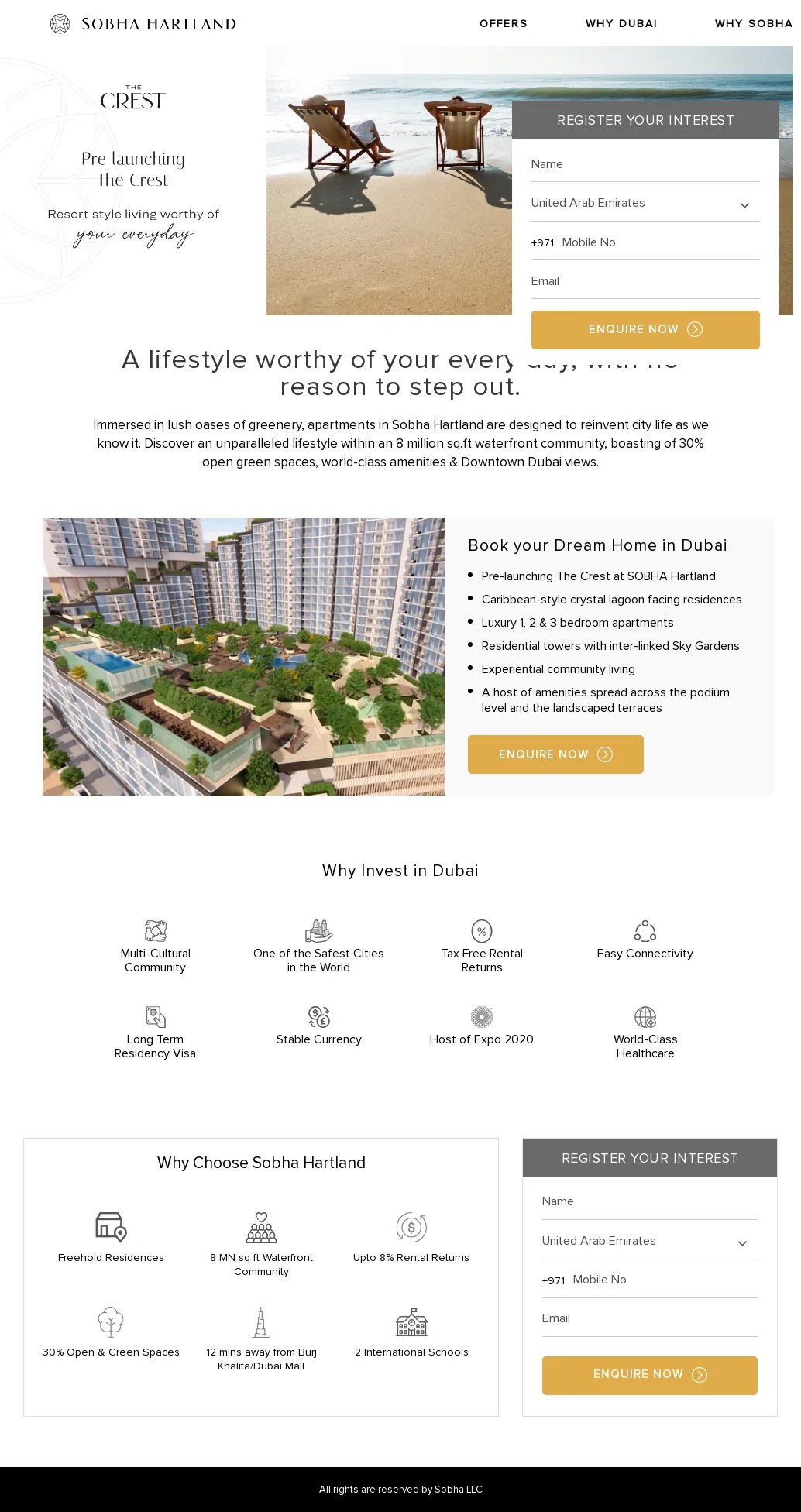
Tip #2: Utilize the Landing Page Well
The great thing about native advertising is that there are a lot of ways for you to connect with your potential clients with the help of the content-oriented landing page.
You can always expect the reader to wait for the page to load and check its contents since they clicked the ad with intent.
The landing page is a great "real estate" to tell the story of the property you are selling. Take for example this lander by Mansion Global that is promoting a Tudor-style mansion located in West Sussex.
The article lovingly describes the place, showing the awe and reverence a property like this should get. They did not hesitate on creating a long-form style of content for a real estate ad.

Tip #3: Make it Interesting!
Everybody loves a good story.
When creating your ad, think about ways that you can tell the story of your property interestingly and engagingly.
Remember, you want your ad to stand out from the other content on the page, so make sure it’s something that will grab attention.
Take a look at this catchy real estate ad below. It is story-based, with the intent of making the user curious enough to check what's inside the old woman's house.

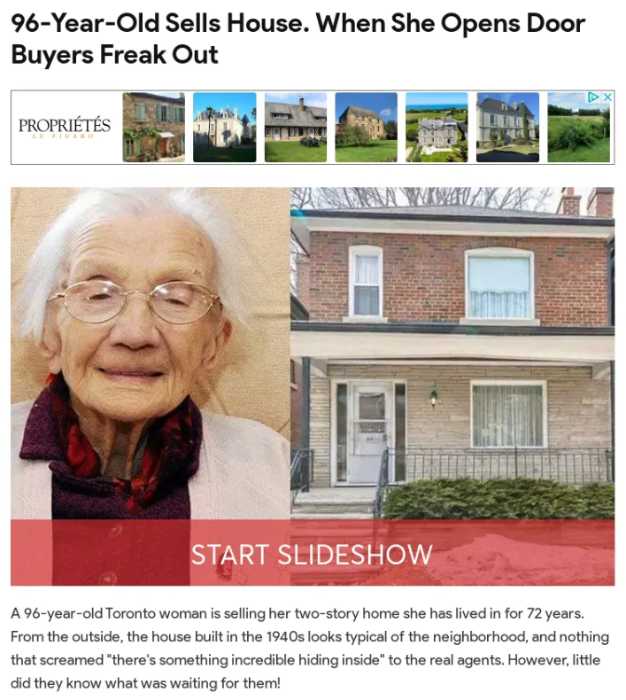
If you're on the market for a house in that area, you would be going through a slideshow-style house tour without even realizing it. This style of marketing can also go viral.
Now that you know where to place your ads, it’s time to start creating them! Here's an extensive list of native advertising providers you can choose from.
Final Thoughts on Real Estate Advertising Online
When it comes to advertising real estate online, the sky is the limit! You can use a variety of platforms to reach potential buyers, and there are endless possibilities when it comes to creative ad design.
Make sure to focus on the benefits of your property, and use strong visuals to help seal the deal. Make certain that you include a call to action so that interested buyers know what to do next.
If you're ready to start using Facebook, Instagram, or native ads for your real estate business, we can help.
We offer a range of services that can help you create and manage your real estate advertising campaigns, including lead generation, ad creation, and more.
Contact us today to learn more about how we can help you reach your real estate marketing goals.
If you liked this article, you might also like these:
- Build a Solid Customer Base through Lead Generation Marketing
- Take It from the Experts: Top Native Advertising Tips for 2022
- Digital Marketing Fundamentals: What Every Pro Advertiser Should Know
- How to Make Videos for Facebook Ads: Everything You Need to Know
- Native Ads for eCommerce: Boost Your Online Business with More Sales

